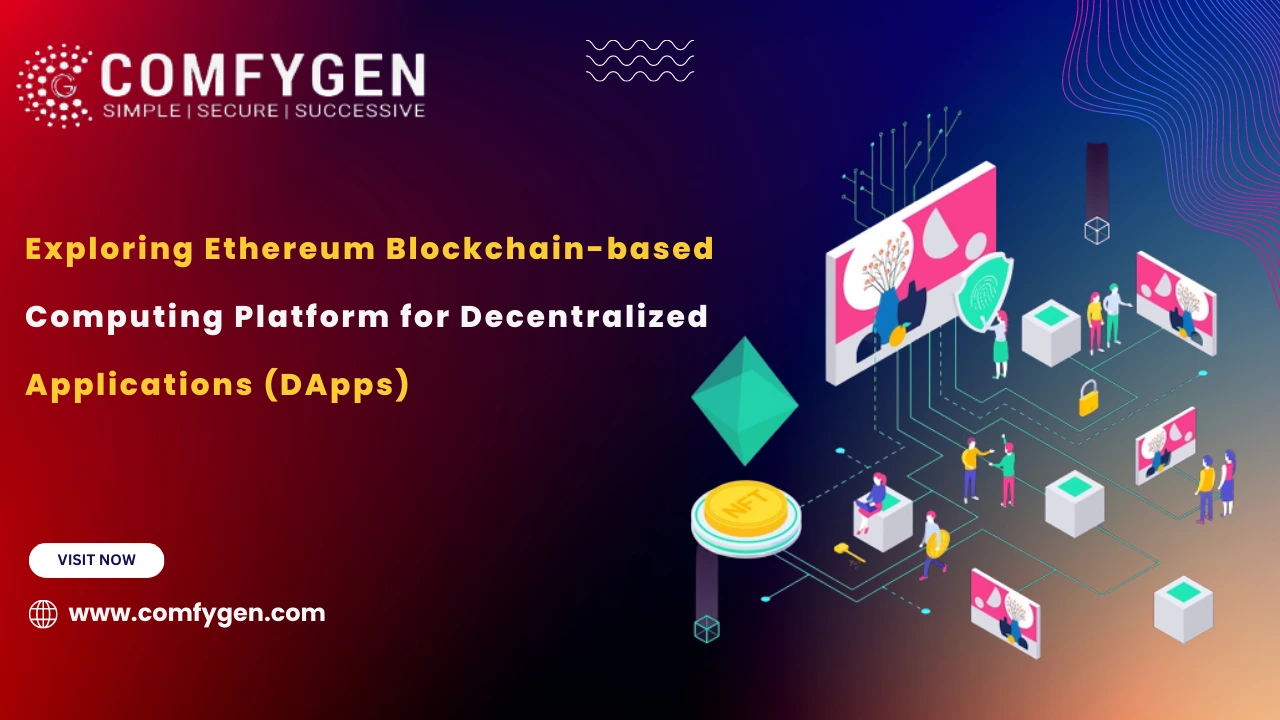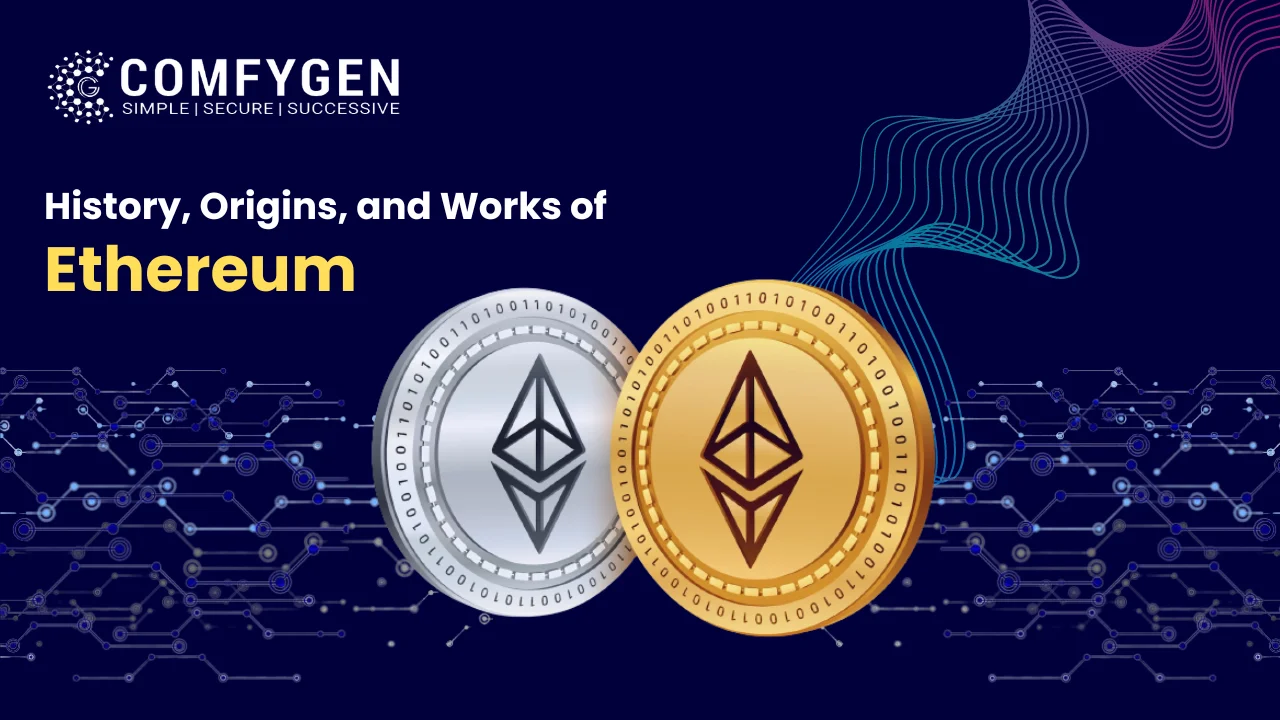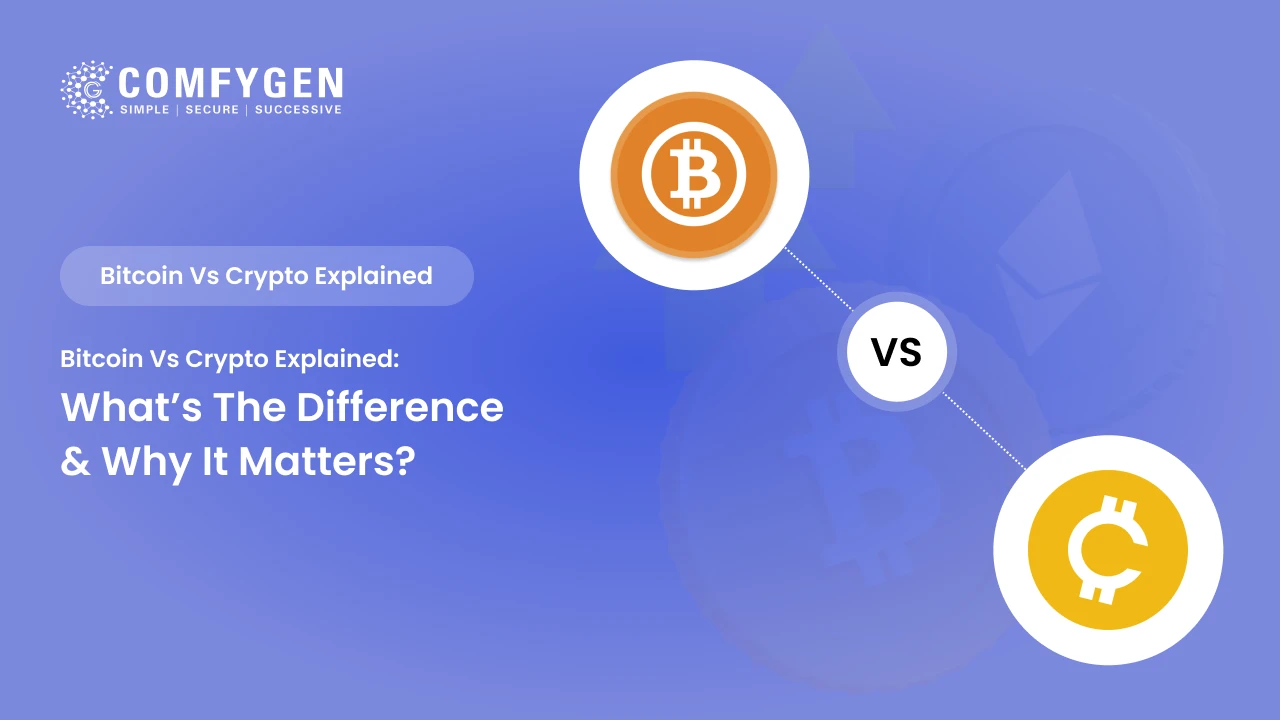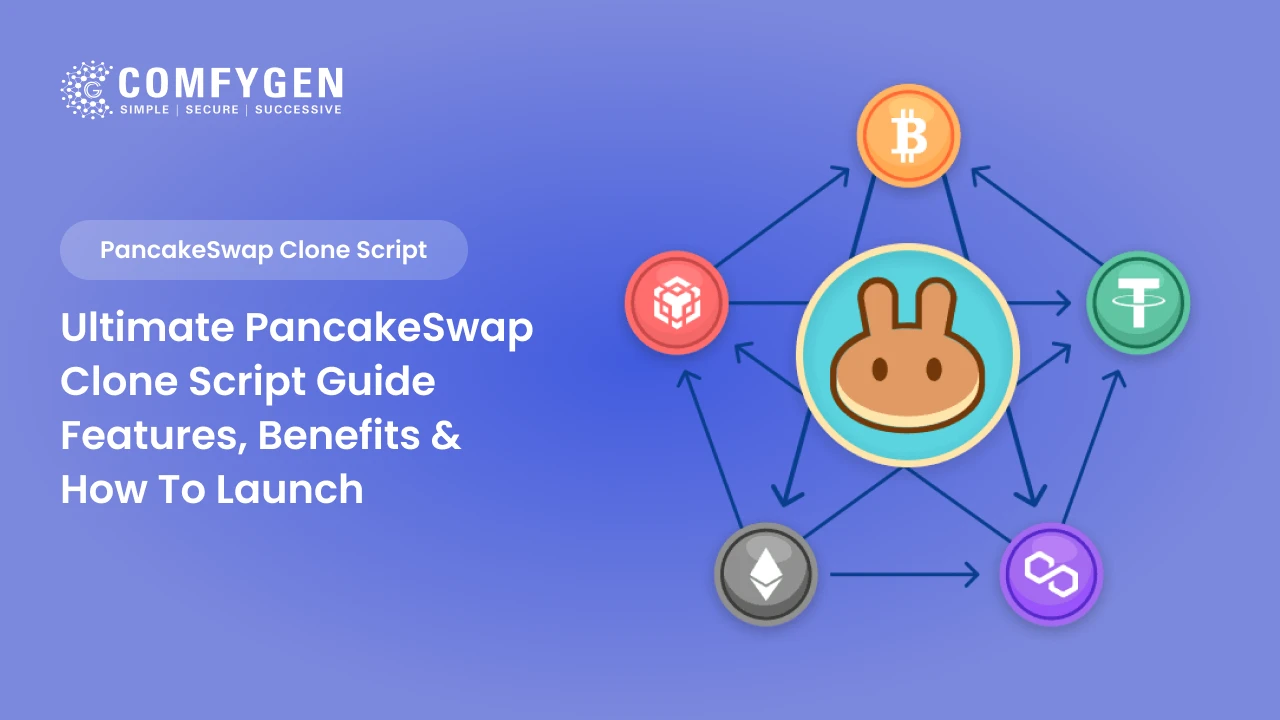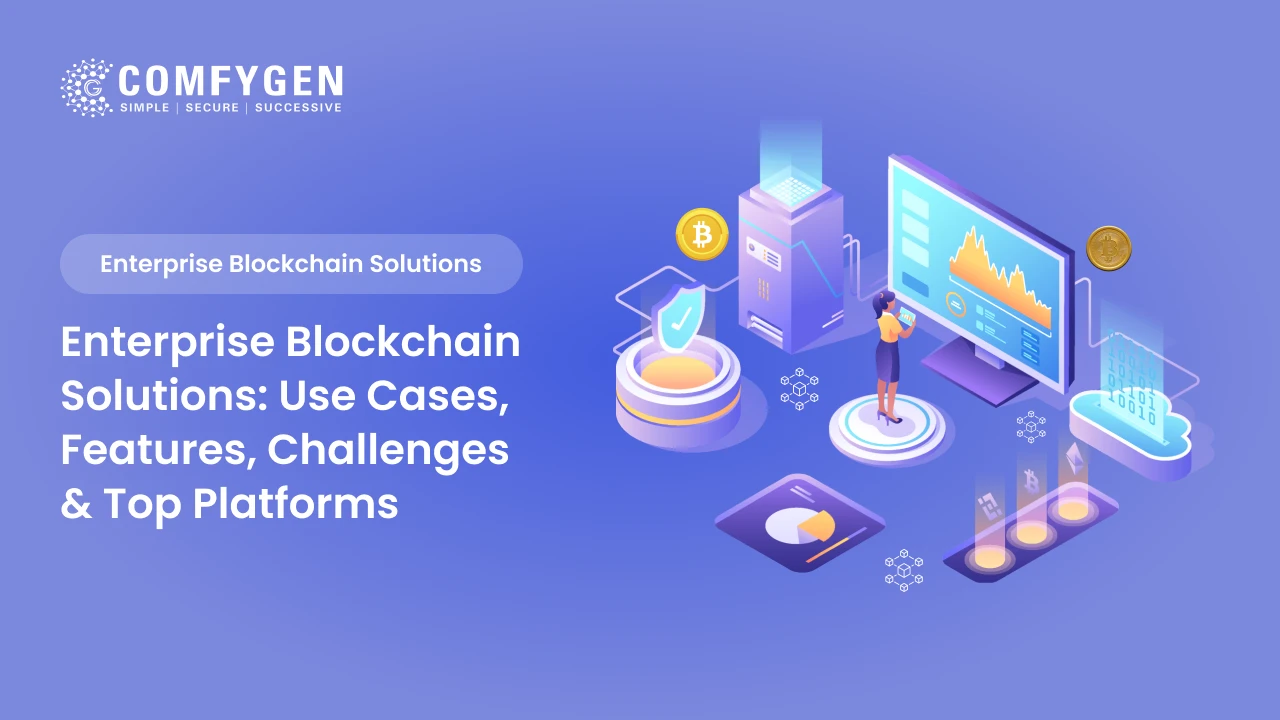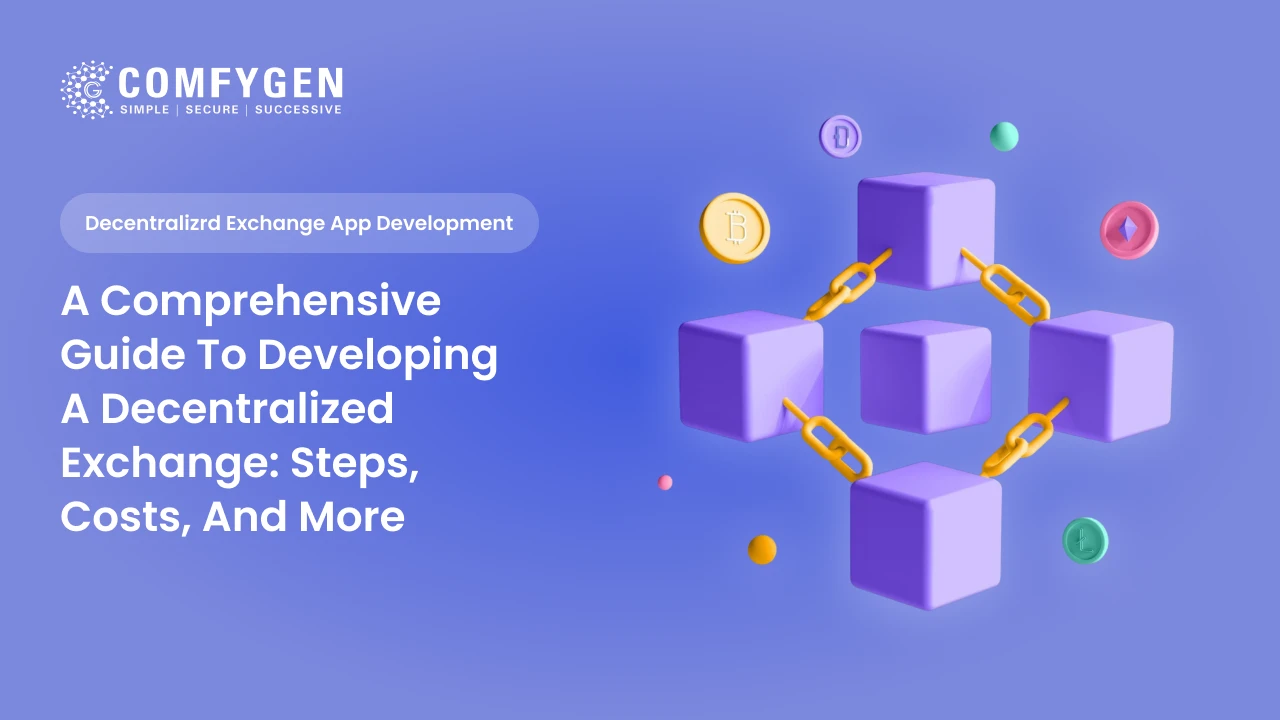Ethereum Blockchain-based Computing Platform for DApps
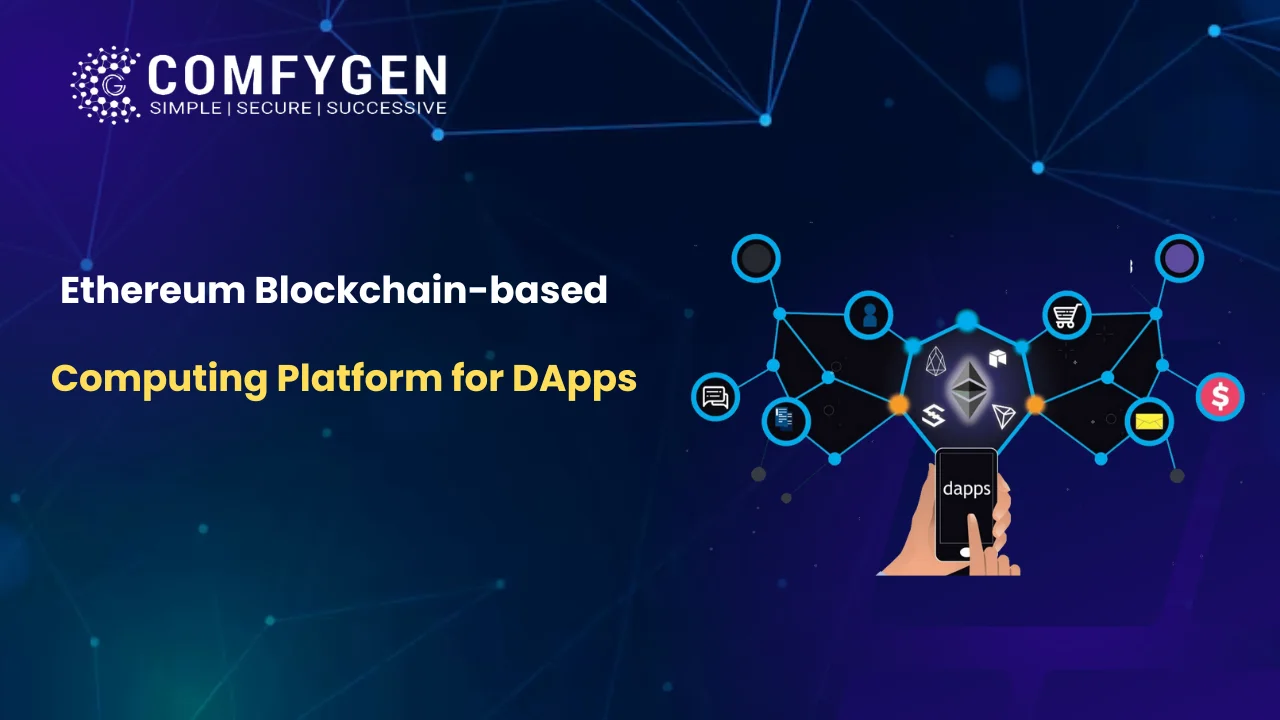
The exploration of Ethereum as a blockchain-based computing platform for Blockchain decentralized applications (DApps) showcases its transformative potential in reshaping industries. Ethereum Blockchain development ingenious integration of smart contracts blockchain facilitates the creation of Blockchain DApps development that operate autonomously, transparently, and securely without intermediaries. The platform’s decentralized nature ensures data integrity, enhancing trust in blockchain mobile application development services. Despite challenges like scalability and gas fees, Ethereum blockchain development services remains a pioneering force that has inspired the development of alternative blockchain development services. As the ecosystem evolves, collaborative efforts among blockchain developers, researchers, and stakeholders are essential to overcome technical limitations and fully unleash Ethereum blockchain development capabilities for Blockchain DApps development services. This ongoing journey to harness Ethereum blockchain development potential signifies an exciting prospect for the future of technology and beyond, underpinning a decentralized paradigm that empowers innovation and redefines traditional models of operation.
Introduction of Ethereum
In the ever-evolving landscape of blockchain development technology, Ethereum blockchain development has emerged as a trailblazer that has fundamentally altered the possibilities of decentralized applications (DApps). Ethereum blockchain development, a blockchain development platform with its native cryptocurrency Ether (ETH), was conceived by Vitalik Buterin in 2013 and launched in 2015. Its innovative approach to smart contract blockchain development and DApps blockchain development has revolutionized the way we conceptualize and interact with decentralized technologies.
Overview of Ethereum
Ethereum is not just a cryptocurrency; it’s a decentralized computing platform that facilitates the creation and execution of powerful business smart contracts and Blockchain. While Bitcoin’s primary use case is as a digital currency, Ethereum blockchain development expands this functionality by enabling blockchain developers to build and deploy their own applications on its blockchain development agency. Smart contracts blockchain development, which are self-executing contracts with the terms of the agreement directly written into code, are at the heart of Ethereum blockchain development capabilities. These contracts automatically execute when predefined conditions are met, eliminating the need for intermediaries and enabling trustless interactions.
Visit Here: How To Launch Your Own Cryptocurrency: Everything You Must Know
Importance of Blockchain Decentralized Applications (DApps)
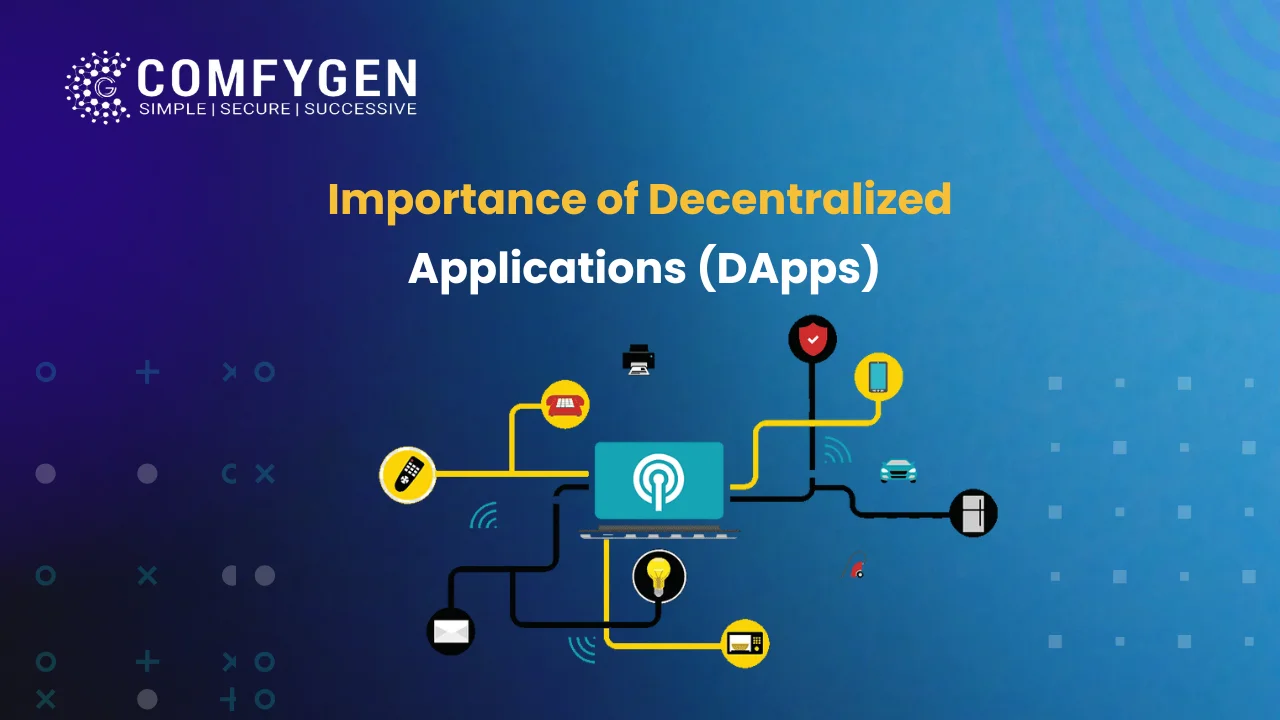
The concept of DApps blockchain development emerged as a response to the limitations of traditional centralized applications. Centralized applications are controlled by a single entity, which raises concerns about data privacy, censorship, and single points of failure. DApps, on the other hand, run on decentralized networks like Ethereum, which offer a range of crucial advantages:
Decentralization and Immutability: DApps blockchain development operate on blockchain development networks, which are decentralized and distributed across a network of computers (nodes). This decentralization ensures that no single entity has absolute control, promoting transparency and reducing the risk of censorship. Additionally, the immutability of blockchain data ensures that once information is recorded, it cannot be altered or deleted without consensus from the network participants.
Enhanced Security: Traditional centralized applications are vulnerable to hacks and data breaches, as attackers often target centralized servers to gain access to user data. DApps blockchain development, built on secure blockchain development networks, are significantly more resilient to such attacks due to the robust encryption and consensus mechanisms they employ.
Censorship Resistance: DApps blockchain development are inherently resistant to censorship. Since they don’t rely on a central authority, there’s no single entity that can censor or shut down the Blockchain mobile application Development services. This is particularly important in environments where freedom of speech and expression are limited.
Interoperability: Ethereum’s open architecture and standardized protocols enable interoperability between DApps. Developers can build applications that seamlessly interact with one another, creating a dynamic ecosystem where different DApps complement and enhance each other’s functionalities.
Tokenization and Decentralized Finance (DeFi): Ethereum blockchain development programmable blockchain development allows for the creation of Solana tokens representing various assets or utilities. This has paved the way for the explosive growth of DeFi – smart contract development, a movement that seeks to recreate traditional financial services using decentralized technologies. DApps within the DeFi space offer services such as lending, borrowing, decentralized exchanges development, and yield farming, often with higher transparency and accessibility than traditional financial systems.
A Step-by-Step Guide! – How to Create Your Own DApp with Ethereum Smart Contract Development
What is a DEX? How do Decentralized Exchanges Work?
Understanding Blockchain Technology
Introduction to Blockchain
Blockchain technology has emerged as a revolutionary force in the realm of digital innovation, transforming traditional industries and reshaping the way we conduct transactions and manage data. At its core, a blockchain is a distributed and decentralized digital ledger that records transactions in a secure, transparent, and tamper-proof manner. Initially introduced as the underlying technology for cryptocurrencies like Bitcoin, blockchain has evolved beyond its origins to find applications across diverse sectors.
A blockchain consists of a chain of interconnected blocks, each containing a set of transactions. These blocks are linked together in chronological order, creating an unbroken and transparent chain of records. What sets blockchain apart is its decentralized nature – it’s maintained by a network of participants (nodes) rather than a central authority. This decentralization ensures that no single entity can manipulate the data or control the network.
Key Features of Blockchain
Decentralization: Blockchain operates on a decentralized network of nodes, each participating in maintaining the integrity of the ledger. This decentralization eliminates the need for a central authority, reducing the risk of single points of failure and enabling trustless interactions.
Transparency and Immutability: Transactions recorded on a blockchain are transparent and visible to all participants in the network. Once data is added to the blockchain, it becomes nearly impossible to alter or delete due to the cryptographic hashes that link each block. This immutability enhances the security and authenticity of the data.
Security: Blockchain employs advanced cryptographic techniques to secure data and transactions. Public and private keys, digital signatures, and cryptographic hashes ensure the confidentiality and integrity of information on the blockchain.
Consensus Mechanisms: Consensus mechanisms establish rules for validating and adding transactions to the blockchain. These mechanisms prevent malicious actors from manipulating the network and ensure agreement among participants.
Trustlessness: Blockchain allows parties to engage in transactions without the need for intermediaries or trust between them. The decentralized nature of the technology ensures that transactions are verified independently by the network.
Smart Contracts: Smart contracts are self-executing scripts that automatically execute predefined actions when certain conditions are met. They enable the creation of complex, automated processes without relying on intermediaries.
These features collectively contribute to the unique capabilities of blockchain technology and its potential to revolutionize various industries by providing secure, transparent, and efficient solutions.
Benefits of Blockchain Technology
Enhanced Security: Blockchain’s cryptographic techniques and decentralized structure make it highly secure against data breaches and cyberattacks. Each transaction is recorded in a block with a unique cryptographic hash, creating a link to the previous block. Tampering with one block would require altering all subsequent blocks, a practically infeasible task.
Transparency and Traceability: Blockchain’s transparency ensures that all participants can view the entire transaction history. This is particularly valuable in supply chain management, where stakeholders can trace the journey of products from origin to destination, verifying authenticity and preventing fraud.
Reduced Intermediaries: Traditional transactions often involve multiple intermediaries, leading to delays and increased costs. With MultiChain Blockchain, participants can engage in peer-to-peer transactions, reducing the need for intermediaries and streamlining processes.
Efficiency and Cost Savings: By eliminating intermediaries, automating processes through smart contracts, and providing real-time transparency, blockchain technology can significantly enhance operational efficiency and reduce costs in various industries.
Glance Over Here: How to Choose a Blockchain Platform for your Business
History and Origins of Ethereum
Ethereum’s history and origins stem from Vitalik Buterin’s vision to create a decentralized platform that goes beyond Bitcoin’s capabilities. In 2013, Buterin published the Ethereum whitepaper, outlining a scripting language-based platform for building complex applications. A successful crowdfunding campaign in 2014 raised over $18 million in Bitcoin to support development. Ethereum’s blockchain went live in 2015, introducing Ether (ETH) as its native cryptocurrency. This marked the advent of smart contracts, revolutionary self-executing codes enabling trustless agreements. Ethereum’s launch prompted the rise of Initial Coin Offerings (ICOs) and the decentralized finance (DeFi) sector. Upgrades followed notably Ethereum 2.0’s shift to Proof of Stake (PoS) consensus for scalability and efficiency. Ethereum’s journey embodies the evolution of blockchain from a simple digital currency to a versatile platform fostering decentralized innovation across industries.
Ethereum’s Role in the Blockchain Ecosystem
Ethereum occupies a pivotal role in the blockchain ecosystem due to its innovative approach to smart contracts and decentralized applications. While Bitcoin primarily focuses on being a digital currency, Ethereum broadens the scope by enabling developers to build DApps that run on its blockchain. These DApps have various use cases, from decentralized finance (DeFi) platforms and non-fungible tokens (NFTs) to supply chain management and identity verification systems.
One of Ethereum’s game-changing aspects is its role in tokenization. It introduced the ERC-20 standard, which laid the foundation for the ICO (Initial Coin Offering) boom, enabling projects to raise funds by issuing tokens on the Ethereum blockchain. Subsequently, other token standards, like ERC-721 for NFTs, emerged, allowing for the representation of unique digital assets on the blockchain.
How Ethereum Works
Ethereum operates as a decentralized, open-source blockchain platform designed to enable the execution of smart contracts and decentralized applications (DApps). At its core, Ethereum employs a distributed network of nodes that collectively maintain a public ledger, recording transactions, and contract code. Smart contracts, self-executing code stored on the blockchain, automate and enforce agreements without intermediaries. Ethereum’s native cryptocurrency, Ether (ETH), is used to compensate participants for processing transactions and executing contracts.
Transactions are grouped into blocks and added to the blockchain through a consensus mechanism called Proof of Stake (PoS), or previously Proof of Work (PoW), ensuring network security and integrity. Ethereum’s Virtual Machine (EVM) executes smart contracts uniformly across nodes, fostering decentralization while also introducing gas fees, which incentivize efficient use of network resources. Ethereum’s ongoing upgrades, like Ethereum 2.0, aim to improve scalability and energy efficiency. In essence, Ethereum’s innovative architecture empowers developers to create decentralized applications that transcend traditional limitations, revolutionizing various industries through trust, autonomy, and transparency.
Decentralized Applications (DApps)
What are Decentralized Applications?
Decentralized Applications (DApps) are software applications that operate on a decentralized network, typically utilizing blockchain technology. Unlike traditional apps that rely on centralized servers, DApps leverage the distributed nature of blockchain to function autonomously, transparently, and securely. They employ smart contracts, self-executing code stored on the blockchain, to automate processes and enforce rules without the need for intermediaries. DApps cover a wide range of functions, from finance and gaming to supply chain management and social networking. They offer enhanced data integrity, user control, and censorship resistance. DApps are at the forefront of the decentralized revolution, reshaping industries by promoting peer-to-peer interactions, reducing reliance on third parties, and fostering a new era of trust, openness, and innovation.
Advantages of DApps
DApps offer a multitude of advantages, making them an attractive proposition for various industries and use cases:
Decentralization and Trust: The elimination of central authorities reduces the risk of single points of failure and censorship. DApps operate on a distributed network, enhancing security and preventing unauthorized alterations to data.
Transparency: Transactions and data on a blockchain are recorded in a transparent and immutable manner. This fosters trust among participants, as anyone can verify the history of transactions.
Security: The consensus mechanisms and cryptographic protocols employed by blockchains enhance security, making DApps more resilient against cyberattacks and data breaches.
Ownership and Control: DApp users have more control over their data and assets. They hold their private keys, enabling them to access, transfer, and manage their resources without relying on third parties.
Reduced Intermediaries: DApps streamline processes by removing intermediaries, leading to quicker and more efficient transactions. This reduces costs and friction in various applications, such as financial services and supply chain management.
Global Accessibility: DApps are accessible to anyone with an internet connection, providing opportunities for individuals in regions with limited access to traditional financial systems or services.
Use Cases and Examples of DApps
The versatility of DApps is showcased through a diverse range of use cases and real-world examples:
Finance and Payments: DApps have transformed the financial landscape with decentralized finance (DeFi) applications. Platforms like Compound and Uniswap enable users to lend, borrow, and trade assets directly, bypassing traditional intermediaries like banks. These DApps provide users with higher interest rates and greater control over their assets.
Gaming: DApps have entered the gaming industry, offering players true ownership of in-game assets. CryptoKitties was an early example, allowing users to collect, breed, and trade virtual cats as unique Crypto Token on the blockchain. This concept has evolved into blockchain-based games like Axie Infinity, where players can earn cryptocurrency by playing the game.
Supply Chain Management: DApps are transforming supply chain management by enhancing transparency and traceability. VeChain is a prime example, offering a blockchain platform that tracks and verifies the origin, quality, and authenticity of products throughout the supply chain.
Social Networking: DApps are redefining social networking app development by returning control of personal data to users. Minds is a decentralized social media platform that rewards users with cryptocurrency for their engagement and content contributions.
Healthcare: DApps are revolutionizing healthcare data management and interoperability. MediBloc is a blockchain-based platform that enables patients to securely store and share their medical records with Healthcare App Development Company, ensuring data integrity and patient control.
Real Estate: DApps are simplifying real estate transactions and ownership. Propy is a platform that uses smart contracts to facilitate real estate purchases, automating the process of transferring property ownership and reducing the need for intermediaries.
Identity Verification: DApps are tackling identity verification issues. Civic offers a decentralized identity verification solution, allowing users to securely store and share identities.
Building on Ethereum
Smart Contracts: The Building Blocks of DApps
Smart contracts are the fundamental building blocks of blockchain-based decentralized applications (DApps). They are self-executing, programmable agreements that automatically execute predefined actions when specific conditions are met on the blockchain. Operating without intermediaries, smart contracts ensure transparency, security, and trust in a tamper-resistant environment.
These contracts facilitate various functions, from token transfers to complex business logic, in sectors like finance, supply chain, and more. By enforcing predefined rules, they mitigate human error and reduce the need for intermediaries, streamlining processes and cutting costs. Ethereum, a pioneering blockchain, popularized smart contracts and their potential to revolutionize industries.
Tools and Technologies for Developing Ethereum
Developing on the Ethereum platform requires a comprehensive set of tools and technologies to facilitate the creation and deployment of DApps. Here are some key components:
Truffle: Truffle is a comprehensive infrastructure for Ethereum development. It provides tools for developing, testing, and monitoring Ethereum solutions. It also includes features like smart contract compilation to help manage and execute binaries.
MetaMask: MetaMask is a browser-friendly tool that functions as a Cryptocurrency Wallet Development and browser extension. It integrates with popular browsers like Chrome, Firefox, and Opera. MetaMask allows users to access and generate Ethereum blockchain development addresses, monitor transfers, and sign transactions securely.
Remix IDE: Remix IDE is an open-source Ethereum Blockchain development tool that supports debugging and compiling Solidity contracts. It can be accessed through a browser or locally and offers features like a code analyzer for efficient development.
Geth: Geth is an Ethereum client implemented in the Go programming language. It serves as a multi-faceted tool, providing functionalities such as mining Ether, interacting with the Blockchain via HTTP, and more.
Ether.js: Ether.js is a library that offers extensive functionality for Ethereum development. It serves as an alternative to Web3.js and supports features like transferring JSON wallets, working with BIP39 mnemonic phrases, and managing HD wallets.
Relatable Blog: Multicurrency Wallet Development A Solution To Manage Multiple Digital Assets
Ganache: Ganache is a dApp testing and monitoring tool. It provides a private blockchain that runs on local devices, offering a secure environment for developing, testing, and monitoring Ethereum smart contracts.
Drizzle: Drizzle is an Ethereum development tool within the TruffleSuite ecosystem. It offers front-end libraries for developing and testing TruffleSuite and Ganache solutions, improving the efficiency and predictability of dApp Blockchain development.
Embark: Embark is a development platform that simplifies the generation and deployment of dApps. It supports the execution of EVM blockchains, storage systems, and communication platforms using serverless HTML5 apps. Embark also integrates with Swarm for contract deployment.
Parity: Parity is another Ethereum Blockchain Development client similar to Geth. It is primarily written in Rust, which offers better memory management and execution efficiency. Parity supports Ethereum development and includes technologies like Substrate Blockchain Development, Polkadot Blockchain Development, and Parity signer.
Infura: Infura is a blockchain development solution that offers various tools and APIs for developers. It provides reliable access to the Ethereum network, enabling the creation of innovative Blockchain Software and Web3 apps.
Read More: Important Things you must know about Diamond Exchange API
Deploying a DApp on Ethereum
Deploying a DApp on the Ethereum network involves several steps, from compiling and testing to deploying and interacting with smart contracts:
Compile: Write the smart contract code using Solidity and compile it into bytecode, which can be understood by the Ethereum Virtual Machine (EVM).
Test: Use tools like Truffle and Ganache to test the smart contracts in a local environment. This helps identify bugs and issues before deploying to the main net.
Deploy: Choose the Ethereum network where you want to deploy your DApp (main network, test net, or private network). Use tools like Truffle or Remix to deploy your smart contracts to the chosen network. Deployment involves submitting a transaction to the network, which includes the bytecode and deployment parameters.
Interact: Once deployed, users can interact with the DApp through various interfaces. These interfaces can be web-based applications or mobile apps that connect to the Ethereum blockchain using libraries like Web3.js.
Manage: As the DApp gains users and transactions, developers need to monitor its performance and address any issues that arise. Smart contracts, being immutable, cannot be changed after deployment. However, upgrades can be managed using techniques like creating new contracts and migrating data.
Ethereum’s Role in Empowering Developers
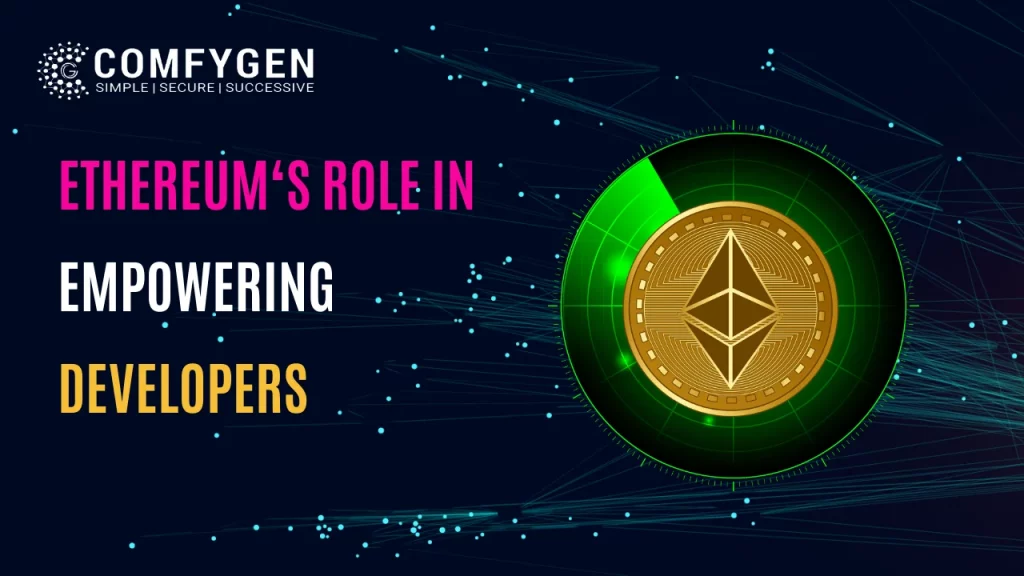
Enabling Innovation with Developer-Friendly Features:
Ethereum, a pioneering blockchain platform, has revolutionized the world of decentralized applications (dApps) by offering a plethora of developer-friendly features that enable innovation on a global scale. At the heart of Ethereum’s appeal to developers lies its groundbreaking concept of “smart contracts.” These self-executing contracts facilitate trustless interactions, automating processes without the need for intermediaries.
Smart contracts are written in Solidity, Ethereum’s programming language specifically designed for building decentralized applications. This language’s syntax is familiar to developers, making the transition into blockchain development smoother. Ethereum’s Virtual Machine (EVM) then compiles and executes these contracts, ensuring their integrity across the network. This seamless integration of smart contracts into the Ethereum ecosystem has opened the doors to diverse use cases, from decentralized finance (DeFi) and non-fungible tokens (NFTs) to supply chain management and identity verification.
Community and Resources for Ethereum Developers:
The Ethereum community’s vibrancy and inclusivity have played a pivotal role in empowering developers. Countless online forums, social media groups, and developer meetups provide a platform for knowledge of White Label Cryptocurrency Exchange and collaboration. Ethereum Improvement Proposals (EIPs) enable developers to participate in the platform’s evolution by suggesting upgrades and changes.
Ethereum’s decentralized nature aligns with its commitment to empowering developers. Unlike traditional platforms, decisions are not solely controlled by a centralized entity but rather involve the consensus of the community. This transparency and decentralization foster a sense of ownership and engagement among developers, making Ethereum more than just a technology platform—it’s a community-driven movement.
A rich array of resources further solidifies Ethereum’s role in nurturing developers. Documentation, tutorials, and open-source projects are readily available, streamlining the learning curve for those entering the ecosystem. Ethereum-focused development tools such as Truffle and Remix provide integrated environments for writing, testing, and deploying smart contracts, ensuring developers have the tools they need to succeed.
Future Potential of Ethereum as a Development Platform:
The future potential of Ethereum as a development platform is nothing short of remarkable. Ethereum 2.0, an upgrade currently underway, promises to address the scalability and energy efficiency issues that have hindered the network. With the transition from a Proof of Work (PoW) to a Proof of Stake (PoS) consensus mechanism, Ethereum will become more sustainable and scalable, accommodating a greater number of transactions without compromising decentralization.
This upgrade will significantly enhance Ethereum’s role as a development platform. High gas fees, a common concern on the current network, will be mitigated, making dApps more accessible and affordable for users. The development community can expect a more seamless and cost-effective experience, driving greater adoption and innovation.
Interoperability is another area where Ethereum is set to make significant strides. Through projects like Polkadot and Cosmos, Ethereum can collaborate with other blockchains, creating a cross-chain ecosystem that combines the strengths of various platforms. This interconnectedness expands the potential of Ethereum-based dApps, enabling them to leverage resources and functionalities from multiple blockchains.
Moreover, Ethereum’s versatility extends beyond its technical capabilities. As regulatory frameworks evolve, Ethereum’s compliant and transparent nature positions it as a preferred platform for various industries. From finance to healthcare and supply chain management, Ethereum’s tamper-proof and auditable smart contracts provide a solid foundation for building secure and accountable applications.
Conclusion
The Ethereum blockchain has revolutionized the landscape of decentralized applications (DApps). Its pioneering smart contract functionality has enabled trustless automation and transparency across various sectors. While Ethereum’s tokenization capabilities have democratized fundraising, scalability issues and environmental concerns stemming from Proof of Work have highlighted the need for Ethereum 2.0’s Proof of Stake upgrade. Despite challenges, Ethereum’s impact is profound—ushering in DeFi, NFTs, and more. As a foundational platform, Ethereum’s journey showcases the potential of blockchain to reshape industries, fostering a decentralized future. As the ecosystem expands, Ethereum’s legacy endures, inspiring future blockchain innovation and solidifying its role in shaping how we engage, transact, and collaborate in the digital age.

Mr. Saddam Husen, (CTO)
Mr. Saddam Husen, CTO at Comfygen, is a renowned Blockchain expert and IT consultant with extensive experience in blockchain development, crypto wallets, DeFi, ICOs, and smart contracts. Passionate about digital transformation, he helps businesses harness blockchain technology’s potential, driving innovation and enhancing IT infrastructure for global success.
Based on Interest
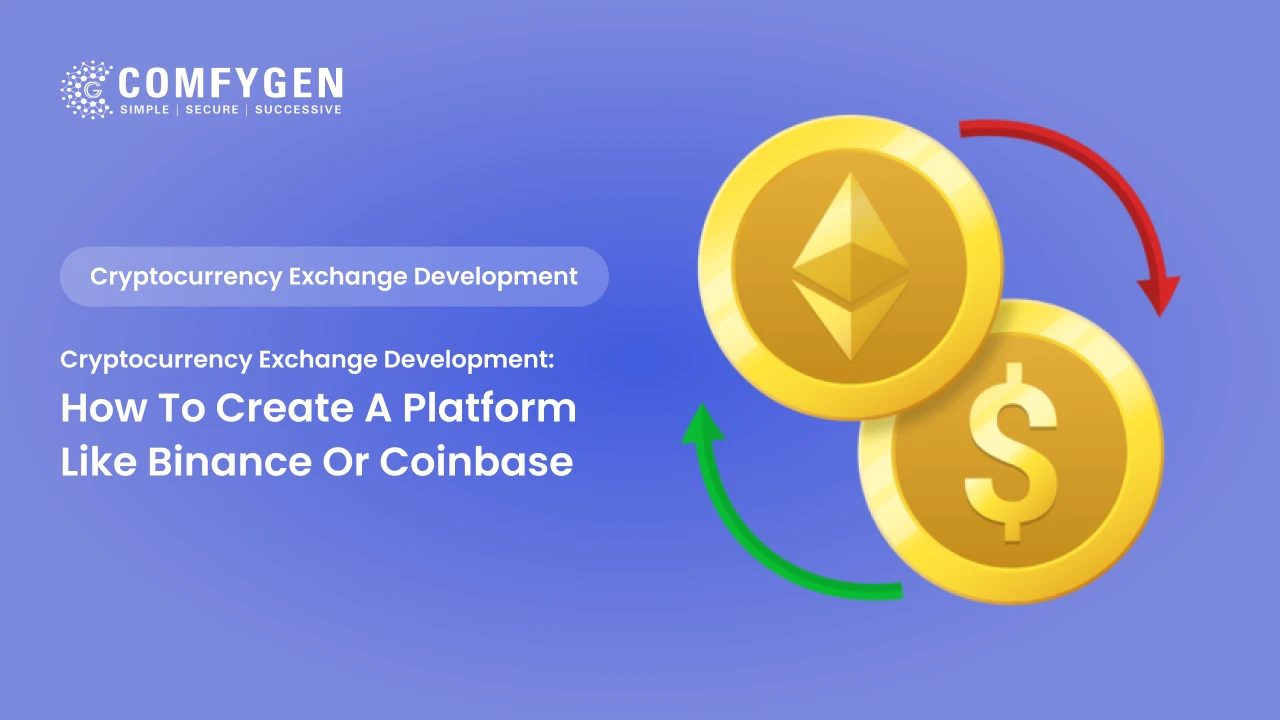
Cryptocurrency Exchange Development: How to Create a Platform Like Binance or Coinbase
The rise of cryptocurrency has revolutionized the financial world, creating new avenues for investment, trading, and technology-driven finance. Among the major…
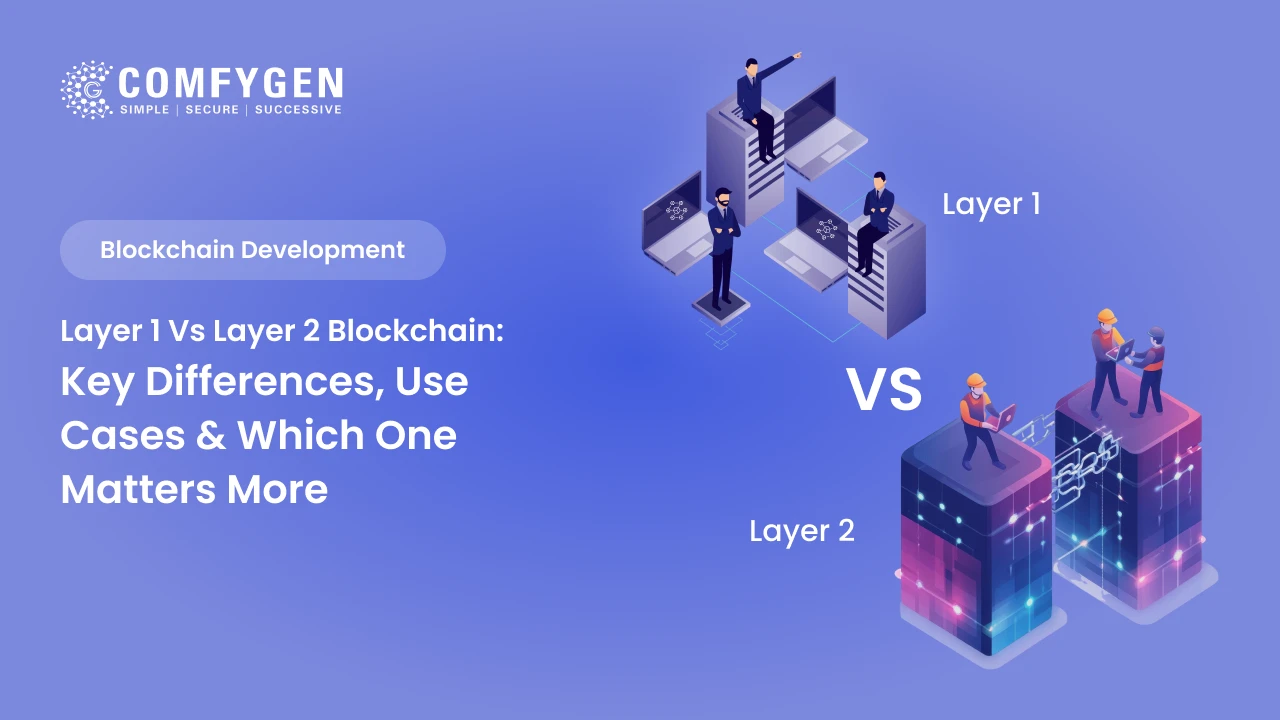
Layer 1 vs Layer 2 Blockchain: Key Differences, Use Cases & Which One Matters More in 2025
Introduction Blockchain technology, once the exclusive domain of cryptocurrencies, has now evolved into a robust tool for various industries, including finance, healthcare,…

